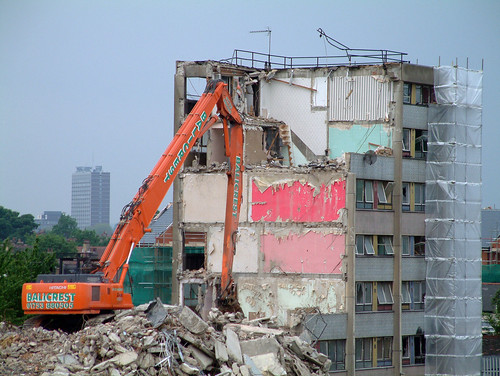 Photo: US National Archives
Photo: US National ArchivesLos Angeles has made the news lately in the world of urban designers and transportation planners with their plan to cap the downtown portion of the Hollywood Freeway with a park. This isn't a new idea, as blogdowntown noted (two years ago!), similar proposals go back at least as far as the mid-80s. Small caps have been constructed in Seattle and Columbus, Ohio, and of course there's the case of Boston's "Big Dig". For more than a decade, Portland has been toying with the idea of various caps on that underused relic of the city's brief Robert Moses fixation, Interstate 405. Seoul has gone them one further and completely removed a freeway, restoring the river beneath and adding some rare green space to the city, and actually improving traffic flows in the area in the process. The chief obstacle has always been cost, LA's plan faces a preliminary price tag of a billion dollars.
I'm not against the idea, rather it makes me wonder how this country ever found the money and political will to build these freeways in the first place. Under the guise of national defense, the Federal-Aid Highway Act of 1956 was passed with little opposition and allocated $25 billion over thirteen years...it wound up costing five times that and going 22 years over schedule. Adjusted for inflation, that would be an initial outlay of nearly $200 billion today. That's a very conservative number, since the price of labor and materials hasn't risen at a level commensurate with inflation and building codes are stricter than they were fifty years ago, especially in earthquake-prone regions. In 1956, the House was split 232-203 (almost identical numbers to today) and the bill passed 388-19...given the state of Congress these days I can just imagine the odds of achieving that same result.
And what did it get us? Five decades of government-subsidized sprawl, urban decay, no real traffic relief and an ever-expanding, ever-aging infrastructure to maintain. I'm not arguing that the country didn't need a federal highway system, but what if it had been done right the first time around? Did we need multiple freeways cutting through every city, or just lines connecting population centers for purposes of commerce and troop deployment? How many congressional districts receive no Interstate highway funding? So far as I can tell, just one: Alaska...though they get plenty of federal money in other forms.
I think the places that have the option of capping freeways got off lucky, even if they can't afford it now. Robert Moses gets a lot of attention (deservedly) for cutting neighborhoods in half via the trench of the Cross-Bronx Expressway, but Richard J. Daley's minions in Chicago's planning department were busy building walls with their freeway money. These elevated roadways placed a physical barrier between the city's expanding African-American neighborhoods on the West and South Sides and the white ethnic neighborhoods across the road. As anybody who's ever walked through a Chicago underpass in winter (or summer, or fall, or...) can attest, they are not the most pleasant pedestrian environments around. These delights serve as de facto homeless shelters, pigeon roosts and garbage dumps. The intersection of Kedzie & Belmont in the Avondale neighborhood is particularly awful. What was once a bustling street corner and intersection of two well-traveled streetcar lines is now entirely in the shadow of the Kennedy Expressway. Belmont Avenue is bisected by 400 feet of railway and freeway viaducts, immediately followed by a large (never-full) parking lot and big box stores. 400 feet is the width of two city blocks east-to-west. I used to live nearby, and found myself annoyed by the state of affairs on pretty much a daily basis.
 You can't tell me that this is the best use of valuable urban real estate. This is one small section of interstate in one small section of one city, when you start to think about how many homes, businesses and other neighborhood amenities were destroyed nationwide it's absolutely mind-boggling. Cost aside, it would be political suicide to even suggest such a thing today. So, given all of the reasons above, why are some people still so in love with the idea of building freeways?
You can't tell me that this is the best use of valuable urban real estate. This is one small section of interstate in one small section of one city, when you start to think about how many homes, businesses and other neighborhood amenities were destroyed nationwide it's absolutely mind-boggling. Cost aside, it would be political suicide to even suggest such a thing today. So, given all of the reasons above, why are some people still so in love with the idea of building freeways?







